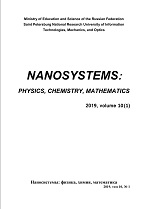|
This article is cited in 7 scientific papers (total in 7 papers)
CHEMISTRY AND MATERIAL SCIENCE
The effect of microtube formation with walls, containing Fe$_3$O$_4$ nanoparticles, via gas-solution interface technique by hydrolysis of the FeCl$_2$ and FeCl$_3$ mixed solution with gaseous ammonia
V. E. Gurenko, V. P. Tolstoy, L. B. Gulina
Institute of Chemistry, Saint Petersburg State University,
26 University Pr., St. Peterhof, Saint Petersburg, 198504, Russia
Abstract:
In this work, microtubes with walls, containing Fe$_3$O$_4$ nanoparticles, obtained by “rolling up” of the interfacial films, were synthesized by the gas-solution interface technique (GSIT), using a mixture of aqueous solutions of FeCl$_2$ and FeCl$_3$ and gaseous ammonia. The synthesized microtubes were characterized by Scanning Electronic Microscopy (SEM), Energy-Dispersive X-ray spectroscopy (EDX), X-Ray Diffraction analysis (XRD) and magnetization measurements. It was established that under optimal synthetic conditions the microtube diameter ranged from 5 to 10 $\mu$m, the length was up to 120 $\mu$m and the thickness of walls was about 0.6 m, the walls themselves being formed by nanoparticles with a size of about 10 nm. The reversible hysteresis behavior, the low coercive force, the low remanence magnetization and the approaching of M$_r$/M$_s$ to zero, confirmed the superparamagnetic nature of the synthesized microtubes. A hypothesis on the formation of microtubes by the gas-solution interface technique was proposed.
Keywords:
Fe$_3$O$_4$, microtubes, magnetic behavior, superparamagnetic, Gas-Solution Interface, GSIT.
Received: 26.07.2017
Revised: 05.08.2017
Citation:
V. E. Gurenko, V. P. Tolstoy, L. B. Gulina, “The effect of microtube formation with walls, containing Fe$_3$O$_4$ nanoparticles, via gas-solution interface technique by hydrolysis of the FeCl$_2$ and FeCl$_3$ mixed solution with gaseous ammonia”, Nanosystems: Physics, Chemistry, Mathematics, 8:4 (2017), 471–475
Linking options:
https://www.mathnet.ru/eng/nano64 https://www.mathnet.ru/eng/nano/v8/i4/p471
|

| Statistics & downloads: |
| Abstract page: | 61 | | Full-text PDF : | 43 |
|




 Contact us:
Contact us: Terms of Use
Terms of Use
 Registration to the website
Registration to the website Logotypes
Logotypes








 Citation in format
Citation in format 
